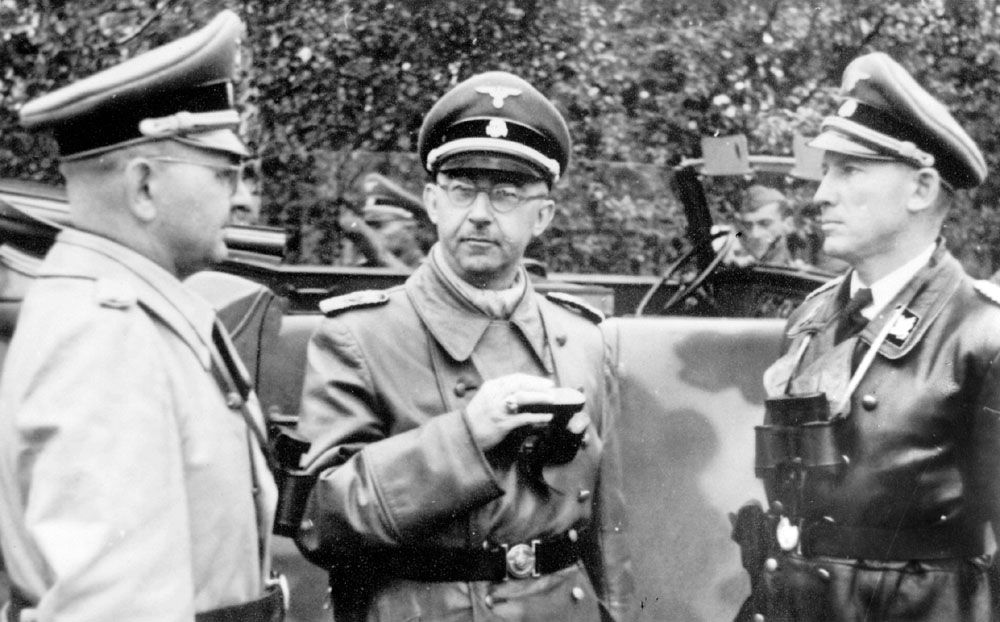
342. The Reichsführer-SS visiting SS-Panzer-Grenadier-Regiment ‘Der Führer’.
Heinrich Himmler, Head of the SS, the police, and the Gestapo.
This postcard shows Himmler (centre) in discussion with Brigadeführer (Major-General) Dr Otto Wachter and Brigadeführer Friedrich Freitag while visiting SS-Panzer-Grenadier-Regiment – Der Führer. Der Führer was a combat unit of the 2nd SS-Panzer-Division – Das Reich, this Division produced more Knights’ Cross winners than any other, sixty-nine in total.
A typical SS Division consisted of some 15,000 fighting men together with between 5,000 and 6,000 support personnel. The reverse of this postcard bears a large contemporary regimental stamp that has subsequently been completed by hand recording the details of the event. Putsch on 9 November 1923. Amazingly, Himmler, somehow managed to avoid both injury and arrest. In July 1928 Himmler married Margarete Boden, almost eight years his senior. The rather unhappy marriage produced one child, a daughter, Gudrun, born on 8 August 1929, whom Himmler adored. The couple separated soon after the birth of their child. Gudrun Himmler was presented as the perfect German child and spoiled by her adoring father. Something rather odd is the fact that Gudrun occasionally accompanied her father when he visited the concentration camps.
Himmler had a reputation as paying great attention to detail; he adopted a methodical approach to all tasks. In January 1929 Hitler appointed Himmler head of a recently formed small group existing within the much larger SA, the SS. Himmler brought his considerable organizational skills into play and set about building up the SS and introducing strict recruitment criteria. Hitler, for his part, took little interest initially, but he approved Himmler’s plans. By 1933 the SS had grown to a force of about 50,000 men. In 1940 Himmler began an affair with his secretary, Hedwig Potthast; she bore him two children, a son Helge, born in 1942, and a daughter Nanette, born in 1944.
During the Second World War the Waffen-SS (Military SS) fought on every front. The men of the Waffen-SS quickly earned a reputation for being very tough soldiers. Himmler had created an élite force, one to be feared on the battlefield. In the end the Waffen-SS consisted of thirty-eight divisions, almost one million men. In April 1934 Himmler was given control of the Geheime Staatspolizei (Gestapo; Secret State Police). In June 1936 he became Chief of German Police with the title Reichsführer-SS. In 1943 he replaced Wilhelm Frick as Reich Minister of the Interior. Himmler had far reaching powers. He oversaw the setting up and running of the first concentration camps prior to the outbreak of the Second World War with his usual efficiency and meticulous attention to detail.
By 1944 Himmler realized that Germany could no longer win the war. This realization eventually led to thoughts of self-preservation. In February 1945 Himmler had a private meeting with Count Folke Bernadotte, a representative of the Swedish Red Cross. The meeting took place to discuss the possible release of Danish and Norwegian prisoners held in the concentration camp system. This was the first stage in Himmler’s bid to gain favour with the Allies. Later, and as the military situation deteriorated, his efforts became more frantic. He went so far as to ask Folke Bernadotte to attempt to arrange a meeting with Eisenhower. His efforts came to nothing. Hitler, on learning of Himmler’s actions commented, that this was the worst act of treachery he had ever known.
With the Führer dead and the war over, Himmler attempted to evade capture. Shaving off his moustache and wearing an eye-patch he further attempted to disguise himself by wearing a tattered sergeant’s uniform. Himmler and his travelling companions were picked up near Bremervörde, west of Hamburg on 21 May 1945. Himmler’s downfall was the fact that he presented brand new identification papers to British troops manning a checkpoint at a time when hardly anyone could produce any papers at all, let alone newly issued and complete. He was subsequently arrested and brought to Lüneburg for questioning. Two days later on 23 May 1945, having admitted his identity and while being medically examined, Heinrich Himmler bit down hard on a cyanide capsule hidden in his mouth and died on the spot. His remains were buried in an unmarked grave on Lüneburg Heath on 26 May 1945.